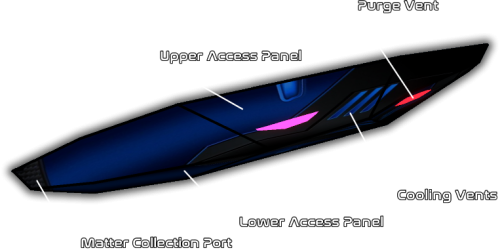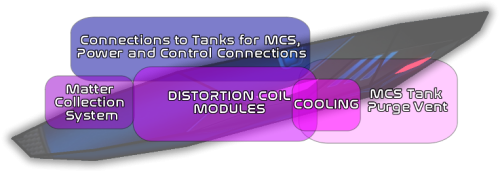Table of Contents
Mizu II Series Continuum Distortion Drives
The Mizu II Series is a Continuum Distortion Drive and Combined Field System developed by the Yugumo Corporation in YE 42. The drives are improved and modernized versions of the Motoyoshi Fleet Yards produced Mizu Series Continuum Distortion Drives.
The Mizu II Series is a Standard System for ships built by the Yugumo Corporation.
About the Mizu II Series of Continuum Distortion Drives
By YE 42, Continuum Distortion Drive technology was commonplace in the Yamatai Star Empire. The old Mizu Series Continuum Distortion Drives were reliable and continued to operate as they were designed. When it came to the decision to improve the drives the approach was more geared towards scalable modular designs that use common parts for easy assembly and replacement.
Most military ships used by the Star Army of Yamatai were being developed with the Integrated CFS Array which the Yugumo Corporation was already producing due to it's contracts to help rebuild the First Expeditionary Fleet and their agreements with Ketsurui Fleet Yards. The decision was made to keep the integrated design for military applications and to continue to produce nacelle/pod type assemblies on civilian vessels.
| Mizu II Series CDD | |
|---|---|
| Designer | Yugumo Corporation |
| Nomenclature | Current - Type 42 |
| Manufacturer | Yugumo Corporation |
| Fielded by | Yugumo Corporation |
| Production | Mass Production |
| Price | Negotiated |
Scalable and Modular Design
The cornerstone of traditional Continuum Distortion Drive is a set of distortion coils which are generally housed in a pod or nacelle structure on the ship they are designed for. The Yugumo Corporation wanted to design a drive assembly that came in several sizes to be applied to different vessels in their upcoming product line. In the previous series of drives, the assemblies got larger depending on the size of the ship they were placed on, so small coils and incrementally larger coils were produced. In the Mizu II Series, however, the coils remain the same standard size but are produced in modular sections, so larger vessels merely have more coil modules. This scalable and modular design mantra would be the basis and economical designs of more than just these drives.
The modular parts for these drives also assist in faster repairs, damaged or malfunctioning components that can be swapped in and swapped out. This design also leads to easy do-it-yourself repairs.
| Mizu II Series CDD | ||
|---|---|---|
| Model | Scale of Ship | Performance |
| Amadare II | Power Armor | See Starship Speed Standard |
| Ripple II | Shuttle/Fighter/Bomber/Small Craft | See Starship Speed Standard |
| Nami II | Escort/Scout/Destroyer Small Ships | See Starship Speed Standard |
| Umi II | Cruisers, Carriers, Battleships | See Starship Speed Standard |
| Tsunami II | Super Carriers, Super Battleships | See Starship Speed Standard |
Standard Pod Design
Nacelle pods have the relatively same design and the Coil Assembly generally shares housing with the Matter Collection System and lines that lead to its storage tanks where the matter is distributed into various systems. Removable access panels allow access to the pods during repairs or when the ship has landed (if capable). Landing capable ships often have pneumatically driven struts that share space in the lower part of the pod. (For Example: The Misha-Class Explorer). Power and control connections to engineering and the KAIMON (or MIKO for older designs) are generally run through pylon structure that attaches the pod to the ship. Cooling vents and heat sinks prevent coils from overheating, in the event of an emergency plasma can be purged from the system via a purge vent which is also shared with the Matter Collection System for purging its tanks and lines.
In the event of catastrophic damage, CDD pods can be ejected from the ship.
Combined Field System
The Mizu II Series, comparable to the similar systems produced by Geshrinari Shipyards and Ketsurui Fleet Yards can function for both propulsion and defense.
Propulsion
The ship propels itself at speeds many times the speed of light by generating continuum distortions in the CFS and nesting them to create asymmetric peristaltic fields. The normal CDD speeds are augmented by working with the forward deflector (located on the underside of the ship). This allows the ship to travel thousands of times the speed of light. Some ships use a combined distortion drive acting as sublight propulsion. Distortion-based systems allow the ship to stop or move nearly instantly because the ship has not “moved.”
Primary Defense
The shields are automatically modulated and phased by the ship's Integrated Electronics System. As the ship's defense against weapons and high-speed impacts such as meteors in space and debris from destroyed starships, the shield is extremely powerful.
Damage Capacity: Damage Rating (Version 3) - See Individual Ship Designs for Tier Statistics.
Nomenclature Catalog
Catalog of Standard Product Nomenclature System.
| Starchaser III-Class Ferry | Yu-Y2-P4200 |
|---|---|
| Misha-Class Explorer | Yu-Y1-P4300 |
| Seiza-Class Cargo Hauler (1B) | Yu-L3-P4300 |
| Asuga-Class Tug | Yu-L1-P4200 |
| Shuryoku-Class Super Freighter | Yu-L2-P4200 |
| Yūgure-class Merchant Destroyer | Yu-D1-P4300 |
| Yoru no Tenshi 'Tenshi II' Light Mechanized Power Armor | Yu-M1-P4200 |
| Tanya-Class Expeditionary Heavy Cruiser | Yu-C1-P4400 |
| Taka-Class Shuttle | Yu-T1-P4400 |
| Mōkin-Class Patrol Craft | Yu-V1-P4400 |
OOC Notes
Andrew created this article on 2020/01/30 21:25.
| Products & Items Database | |
|---|---|
| Product Categories | subsystems |
| Product Name | Type 42 - Mizu II Series Continuum Distortion Drives |
| Nomenclature | Type 42 - Continuum Distortion Drives |
| Manufacturer | Yugumo Corporation, Yugumo Fleetworks |
| Year Released | YE 42 |


